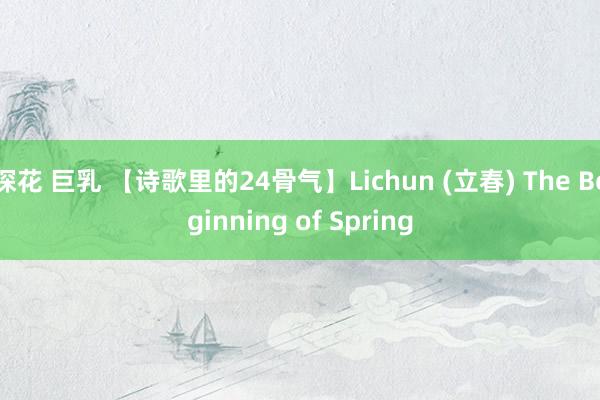
Lichun, or the Beginning of Spring, is the first of the 24 solar terms in the Chinese calendar that for thousands of years has guided farmers and forecast the weather.
Falling on February 3rd, 4th, or 5th, Lichun marks the end of the winter and the beginning of revival, a new season of growth. The weather becomes noticeably warmer, and plants show the first signs of coming back to life.
On this day, Zhang Shi, a poet and scholar in Song Dynasty, described the vibrant and lively beginning of spring as such:
律回岁晚冰霜少,春到东说念主间草木知。
Lǜ huí suì wǎn bīng shuāng shǎo, chūn dào rén jiān cǎo mù zhī.
Warmth returns. Ice and frost grow thin. The grass and trees feel the coming of another spring.
便觉目前贸易满,东风吹水绿芜乱。
Biàn jué yǎn qián sheng yì mǎn, dōng fēng chuī shuǐ lǜ cēn cī
Now everything before me is lush and verdant, green water ripples here and there with the wind.
His poem describes Lichun as a prelude to spring, a time when nature arises from the winter pause. Flowers and grass grow, and the world becomes vibrant once more. Lichun signifies renewal, hope, and new beginnings.
With the onset of Lichun, people start to prepare for spring to come. One tradition is eating spring rolls. Another more unusual custom involves "beating the spring cattle," which isn't as cruel as it sounds.
A "cow" made of paper, mud or clay, is beaten by farmers with a colorful club or a whip, symbolically dispelling the winter laziness of the cattle, while actually dispelling their own.
Wang Zi, another Tang Dynasty sage, seeing the sceneries on Lichun, wrote:
泥牛鞭散六街尘,生菜挑来叶叶春。从此雪消风自软,梅花合让柳条新。
Ní niú biān sàn liù jiē chén, sheng cài tiāo lái yè yè chūn.
Whipping the mud cows makes the dust waft along the streets,
and the fresh lettuce sends the message of spring.
从此雪消风自软,梅花合让柳条新。
Cóng cǐ xuě xiāo fēng zì ruǎn, méi huā hé ràng liǔ tiáo xīn.
The snow disappears and the wind softens. The plum blossoms as willows unfold their buds.
On this day, people, bid farewell to the weakening winter and take time to reflect on the past and embrace the future with hope and optimism. They cherish the beauty of nature and take inspiration from the resilience and strength of the world around them.
Each new season brings hope for a prosperous year of love, happiness, and success.
立春
立春,即春之起首,为农历中二十四骨气之首。二十四骨气为指令农事、瞻望天气而制定。在公历里,立春的日历为2月3日、4日或5日,它标识着极冷的放置,明示着勃勃盼望、万物勃发的新季节的运转,具有攻击地位。立春时节,天气显明转暖,万物再度运转助长。
在这天,宋代诗东说念目的栻曾写说念:“律回岁晚冰霜少,春到东说念主间草木知。便觉目前贸易满,东风吹水绿芜乱。”从诗中不错看出,立春是春之序曲,是万物复苏、草木助长,全国复原盼望的时节。它寓意着但愿、一元复始和茂密朝气。
从立春运转,东说念主们运转为春天的到来作念准备。在中国文化中,立春有多种习俗和传统。其中一项便是吃春饼和春卷。中国民间在立春本日也有“打春”大约“鞭春牛”的习俗。农民用彩色棍棒或鞭子抽打纸、泥或粘土制成的“牛”,遣散牛群冬季的懒惰以祈求丰充。宋朝诗东说念主王镃在他的诗中曾提到这一习俗:“泥牛鞭散六街尘,生菜挑来叶叶春。从此雪消风自软,梅花合让柳条新。”
东说念主们在告别严寒的冬天、迎来勃勃盼望的春天的同期,也在这一天反想昔时,怀着但愿和乐不雅拥抱异日。他们帮忙当然之好意思,并从周围死灰复燃的全国中领受力量和灵感,期盼着立春事后新的一年能幸福富贵,充满爱、兴隆与到手。
